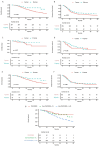Perioperative Clinical Usage of Phellinus Linteus as a Nutraceutical for Non-FOLFIRINOX-Based Postoperative Adjuvant Chemotherapy for Resected Pancreatic Cancer: A Retrospective Cohort Study
- PMID: 40590265
- PMCID: PMC12214309
- DOI: 10.1177/15347354251353499
Perioperative Clinical Usage of Phellinus Linteus as a Nutraceutical for Non-FOLFIRINOX-Based Postoperative Adjuvant Chemotherapy for Resected Pancreatic Cancer: A Retrospective Cohort Study
Abstract
Introduction: Most patients with pancreatic cancer experience systemic recurrence within 1 to 2 years after radical pancreatectomy. Phellinus linteus (PL) has demonstrated anti-inflammatory, antioxidant, and anti-cancer properties, suggesting potential as an adjunct to cancer therapy. This study aimed to evaluate the long-term oncological impact of perioperative PL in resected pancreatic cancer.
Method: This retrospective cohort study included 407 patients who underwent curative resection and adjuvant chemotherapy for pancreatic cancer at Severance Hospital (2012-2022). Among them, 103 patients who began PL postoperatively and continued throughout treatment were assigned to the PL group; 304 patients without PL intake comprised the control group.
Results: The mean overall survival (OS) was significantly longer in the PL group (47.0 months; 95% CI: 42.8-51.1) than in the control group (35.0 months; 95% CI: 30.3-39.7; P < .001). Recurrence-free survival (RFS) showed a borderline improvement (P = .053). PL use was marginally associated with improved OS in multivariate analysis (HR: 0.614; 95% CI: 0.376-1.002; P = .051). Subgroup analysis showed no significant OS or RFS benefit with PL in patients receiving FOLFIRINOX. However, among patients treated with non-FOLFIRINOX regimens, PL use led to significantly better OS (43.9 months vs 35.0 months; P = .021), though RFS remained similar. Notably, the OS of the non-FOLFIRINOX + PL group was comparable to that of the FOLFIRINOX group (P = .332) and superior to the non-FOLFIRINOX control group (P = .021).
Conclusion: PL may enhance survival in resected pancreatic cancer, particularly in patients receiving non-FOLFIRINOX chemotherapy, supporting its role as a potential adjunct when FOLFIRINOX is not feasible.
Keywords: adjuvant; chemotherapy; nutriceuticals; pancreatectomy; pancreatic cancer; phellinus linteus extract.
Conflict of interest statement
Declaration of Conflicting InterestsThe author(s) declared no potential conflicts of interest with respect to the research, authorship, and/or publication of this article.
Figures



Similar articles
-
Adjuvant modified FOLFIRINOX for resected pancreatic adenocarcinoma: clinical insights and genomic features from a large contemporary cohort.J Natl Cancer Inst. 2025 Mar 1;117(3):496-506. doi: 10.1093/jnci/djae269. J Natl Cancer Inst. 2025. PMID: 39460946
-
The effectiveness and cost-effectiveness of carmustine implants and temozolomide for the treatment of newly diagnosed high-grade glioma: a systematic review and economic evaluation.Health Technol Assess. 2007 Nov;11(45):iii-iv, ix-221. doi: 10.3310/hta11450. Health Technol Assess. 2007. PMID: 17999840
-
Chemotherapy and radiotherapy for advanced pancreatic cancer.Cochrane Database Syst Rev. 2024 Dec 5;12(12):CD011044. doi: 10.1002/14651858.CD011044.pub3. Cochrane Database Syst Rev. 2024. PMID: 39635901
-
Chemotherapy for advanced gastric cancer.Cochrane Database Syst Rev. 2017 Aug 29;8(8):CD004064. doi: 10.1002/14651858.CD004064.pub4. Cochrane Database Syst Rev. 2017. PMID: 28850174 Free PMC article.
-
FOLFIRINOX for locally advanced pancreatic cancer: a systematic review and patient-level meta-analysis.Lancet Oncol. 2016 Jun;17(6):801-810. doi: 10.1016/S1470-2045(16)00172-8. Epub 2016 May 6. Lancet Oncol. 2016. PMID: 27160474 Free PMC article.
References
-
- Stoop TF, Theijse RT, Seelen LWF, et al. Preoperative chemotherapy, radiotherapy and surgical decision-making in patients with borderline resectable and locally advanced pancreatic cancer. Nat Rev Gastroenterol Hepatol. 2024;21(2):101-124. - PubMed
Publication types
MeSH terms
Substances
LinkOut - more resources
Full Text Sources
Medical

